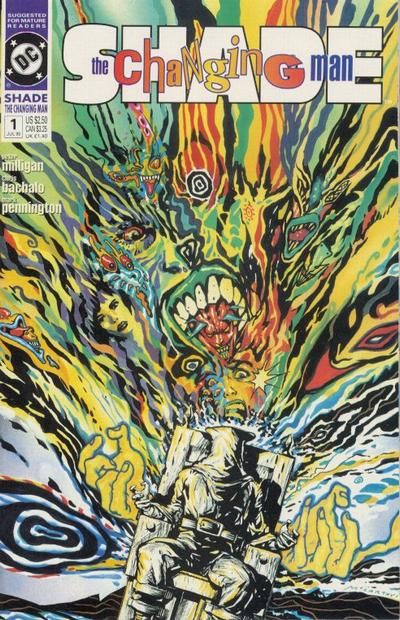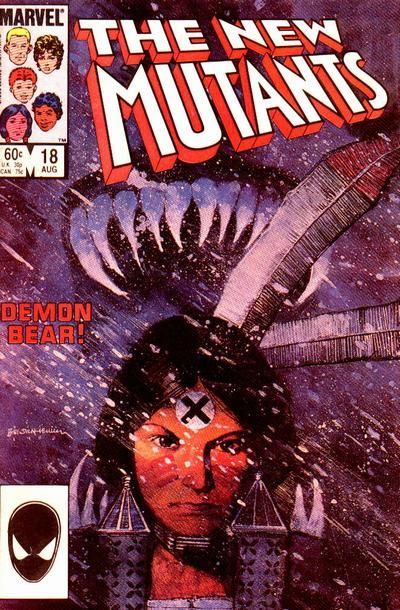Here are the next five runs based on a vote of nearly 700 Comics Should Be Good readers!
Enjoy!
70. Brian Michael Bendis and Michael Avon Oeming's Powers - 134 points (1 first place vote)
Powers Vol. 1 #1-37, Powers Vol. 2 #1-current (#27)
Brian Michael Bendis was already gaining a bit of a name for himself as a writer of crime comics, with the acclaimed comics Goldfish, Jinx and most notably, Torso, so Powers was a reasonable evolution of his craft.
The series, co-created with series artist, Michael Avon Oeming, follows two cops in a world of superheroes, and the various events that occur when you're a cop in a world filled with superheroes.
Noted for his dialogue, Bendis spent a great deal of time establishing the main characters, Christian Walker (a former superhero himself) and his partner, Deena Pilgrim, as the pair got caught up in all sorts of super-powered trouble.
Towards the end of the first series at Image, Bendis gave us the background of Walker's life, who apparently was a bit of an immortal, so we saw Christian literally evolve, from his days as an ape to modern times.
After the Image series ended, the book moved to Marvel, where it is being published through Marvel's ICON line of creator-owned comics.
Oeming's contributions should not be overlooked, as his expressive artwork lends a great deal of humanity to Bendis' dialogue, which is meant to evoke how "real" people talk.
69. Peter David's 1st Run on X-Factor - 140 points (2 first place votes)
X-Factor #70 - 90
In what has become a bit of a pattern when it comes to acclaimed comic books, in 1991, when Peter David took over X-Factor, the book was not exactly the highest profile comic book. The first 69 issues starred the original members of the X-Men, but in 1991, X-Men was expanded to two comic books, and the original members rejoined the X-Men, leaving X-Factor without any team members.
So what David did was put together a team made up of the characters that no one wanted in the other X-Men titles, namely Havok, Polaris, Guido, Madrox the Multiple Man and Wolfsbane. In the first issue, David added Quicksilver, as well. The team worked for the government (following up the disastrous Freedom Force team) and was led by Val Cooper.
With the amount of minor characters in the book, David was given a lot more freedom to do what he wanted, so he treated the book as a humor title, much in the same vein as what Keith Giffen and JM DeMatteis had done five years earlier with their Justice League International comics.
This was not to say that the book was all fun and games, though, as David did work in a number of social issues into his run, particularly some rather poignant looks at families being given the option of testing to see if their unborn children were mutants, and if they were, given the chance to abort.
Larry Stroman was the artist on the first 10 or so issues of David's run, and a variety of artists followed him, most notably Joe Quesada, who produced perhaps the most acclaimed issue of the book, where the team are all forced to go see a shrink (Doc Samson), and David spent the issue investigating each of the personalities of the team, including probably the best take on Quicksilver's personality ever.
Sadly, as the comic market was going through a speculator boom, crossovers became a bigger deal, and David's run was getting interrupted more and more by crossovers (this is noted with the infamous issue of X-Factor that starred only Wolverine, Cable and Bishop - none of which, of course, were X-Factor characters), and his actual storylines kept getting the bump. So David decided it better to simply leave the book.
Years later, David returned to the characters, first with a Madrox mini-series, and then with a new X-Factor ongoing series, this time with X-Factor being the name of Madrox's private investigation firm, where Wolfsbane and Guido went to work with him. This run also got decent support, to the tune of 63 points.
68. Alan Moore's Top Ten - 141 points (3 first place votes)
Top 10 #1-12, Top 10: The Forty-Niners OGN, Smax #1-5
This is the second comic in this group to be about police in a world of superheroes! But this time, Alan Moore's Top 10 is about police officers who ARE superheroes, which is normal enough, as nearly EVERYone in the city of Neopolis has superpowers and costumes, from the cops to the robbers to the civilians.
The artwork was by Gene Ha and Zander Cannon, who drew the 12 issues series together, and then each drew one of the two spin-offs by themselves (Ha handling the Forty-Niners, which tells the history of Neopolis and Cannon taking Smax, a spin-off starring one of the cops from Top 10).
Top 10 refers to the 10th Precinct, which is who the book follows, in a riff on Hill Street Blues, only with superheroes.
Moore uses the opportunity of a city filled with superheroes to make many pointed observations about superheroes, mostly comical ones. However, the book is also a character-driven comic, as well, it is just that the characters are absolutely bizarre, so their dramas are, as well. Moore, though, never treats their bizarre dramas as anything but serious problems, which gives the book a truly human feel in an otherwise superhuman environment.
There was a sequel to the series published in 2005, but Moore was not involved.
67. Peter Milligan's Shade, the Changing Man- 142 points (4 first place votes)
Shade, the Changing Man Vol. 2 #1-70
In 1990, Peter Milligan took hold of a short-lived Steve Ditko superhero, Shade, the Changing Man, and went nuts with the idea. Ditko's Shade was an other-dimensional agent who was framed, so went on the run with his powerful M-Vest (which stood for Miraco-Vest) to clear his name. In Milligan's take, Shade was sent to Earth to save the planet from a swath of madness - his M-Vest was now a Madness-Vest, and he could use it to alter reality.
Brendan McCarthy designed the characters, and Chris Bachalo, in his first major comics work, drew the series, which drew much acclaim for both its surreal plots and for its intriguing character interactions.
The madness was called "The American Scream," and Shade encountered a young woman, Kathy, who was recovering from some massive trauma (her parents were murdered by a serial killer, and her boyfriend was killed by the police because they felt he was the killer, as her boyfriend was black) - Shade somehow convinced her to go along with him on his journey to stop the American Scream, and the two eventually fell in love (even though when Shade showed up on Earth, he took the body of the serial killer, who had just been executed).
However, a great deal of twists and turns happen along the way, including Shade getting killed, like, five times or so, with him being reincarnated each time in a different dead body (once as a woman!).
Along the way, Kathy and Shade also added another traveling companion, a woman named Lenny. The trio had quite the relationship.
As noted above, the surreal nature of the comic was probably the most striking aspect of the book, specifically Chris Bachalo slowly coming into his own as one of the bigger artists of his time. The book really never recovered from Bachalo's departure, and ended with issue #70.
66. Chris Claremont's New Mutants - 144 points (4 first place votes)
Marvel Graphic Novel #4, New Mutants #1-54, Annuals #1-3
Almost all the votes were specifically for the run Claremont did with artist Bill Sienkiewicz, which lasted for New Mutants #18-31, 35-38, but enough just said "Chris Claremont's New Mutants" that I just combined all of the votes into one "Chris Claremont's New Mutants."
New Mutants was the very first ongoing spin-off series of the X-Men, the first of many.
After introducing the characters in Marvel Graphic Novel #4, with artist Bob McLeod, Claremont and McLeod launched the ongoing series, which featured the adventures of Cannonball, Sunspot, Psyche, Karma and Wolfsbane, the newest students at Xavier's School for Gifted Youngsters.
Claremont had a fairly good eye for teen dialogue, and the book was an engaging place for stories of the teen mutants, but the book really went to another level when artist Bill Sienkiewicz came to the title, hot off of his acclaimed run on Moon Knight, where his art experimentation had begun to catch many reader's eyes.
Claremont shifted the tone of the series to match Sienkiewicz's style, which was notably darker than most Marvel comics of the time, so Claremont's scripts also got darker, dealing with ideas of mysticism, mental disorders and bizarre psychic realities.
Oh, and the group all liked to watch Magnum PI, which was cool, because I like Magnum PI.
Sienkiewicz took some time off to work on a Daredevil project, then left the book for good with #38. Claremont held on for another year or so, before giving way to the editor of the title, Louise Simonson.






